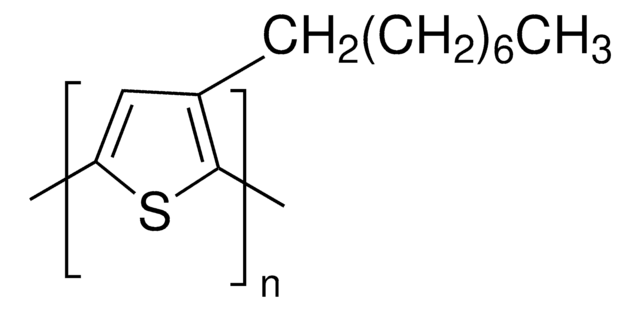687316
PEDOT
bis-PEG, lauryl terminated, 0.7 wt. % (nitromethane dispersion)
Synonym(s):
Aedotron™ C3-NM, C12-PEG-block-PEDOT-block-PEG-C12, PEDOT:PEG
About This Item
Recommended Products
product name
Poly(3,4-ethylenedioxythiophene), bis-poly(ethyleneglycol), lauryl terminated, 0.7 wt. % (dispersion in nitromethane)
form
liquid (dispersion)
contains
perchlorate as dopant
composition
Acetonitrile, 4-8 wt. %
Aedotron™- C3 polymer, 0.2-0.7 wt. %
Nitromethane, 90-95 wt. %
proprietary processing additive, 0.1-0.7 wt. %
Propylene glycol, 0.0-0.3 wt. %
concentration
0.5-0.9 wt. % (content of dispersion)
0.7 wt. % (dispersion in nitromethane)
surface resistivity
600-3000 Ω/sq
transmittance
70-85%
particle size
200-600 nm
conductivity
10-60 S/cm
Looking for similar products? Visit Product Comparison Guide
General description
Application
Features and Benefits
Caution
Legal Information
Signal Word
Danger
Hazard Statements
Precautionary Statements
Hazard Classifications
Acute Tox. 4 Inhalation - Acute Tox. 4 Oral - Carc. 2 - Flam. Liq. 2 - Repr. 2
Storage Class Code
3 - Flammable liquids
WGK
WGK 2
Flash Point(F)
71.6 °F - closed cup
Flash Point(C)
22 °C - closed cup
Certificates of Analysis (COA)
Search for Certificates of Analysis (COA) by entering the products Lot/Batch Number. Lot and Batch Numbers can be found on a product’s label following the words ‘Lot’ or ‘Batch’.
Already Own This Product?
Find documentation for the products that you have recently purchased in the Document Library.
Customers Also Viewed
Articles
In the field of organic printable electronics, such as OLEDs and organic photovoltaics (OPVs), improved organic conducting and semiconducting materials are needed. The progress in two fields is reviewed in this article.
In the field of organic printable electronics, such as OLEDs and organic photovoltaics (OPVs), improved organic conducting and semiconducting materials are needed. The progress in two fields is reviewed in this article.
In the field of organic printable electronics, such as OLEDs and organic photovoltaics (OPVs), improved organic conducting and semiconducting materials are needed. The progress in two fields is reviewed in this article.
In the field of organic printable electronics, such as OLEDs and organic photovoltaics (OPVs), improved organic conducting and semiconducting materials are needed. The progress in two fields is reviewed in this article.
Our team of scientists has experience in all areas of research including Life Science, Material Science, Chemical Synthesis, Chromatography, Analytical and many others.
Contact Technical Service


![1,3,5-Tris[(3-methylphenyl)phenylamino]benzene 97%](/deepweb/assets/sigmaaldrich/product/structures/169/328/32782c27-7421-44c4-9401-58cf69e87f6c/640/32782c27-7421-44c4-9401-58cf69e87f6c.png)







